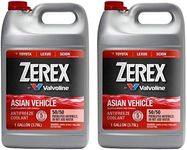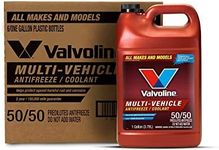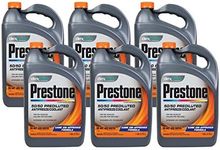Buying Guide for the Best Coolant Additives
Choosing the right coolant additive for your vehicle is crucial for maintaining the engine's performance and longevity. Coolant additives help in preventing corrosion, lubricating the water pump, and improving the heat transfer properties of the coolant. When selecting a coolant additive, it's important to consider several key specifications to ensure it meets your vehicle's needs and operating conditions.Type of Coolant AdditiveCoolant additives come in different types, such as organic acid technology (OAT), hybrid organic acid technology (HOAT), and inorganic acid technology (IAT). Each type has different properties and compatibility with various engine materials. OAT additives are typically long-lasting and suitable for modern engines, while IAT additives are more traditional and may require more frequent changes. HOAT additives combine the benefits of both OAT and IAT. To pick the right one, check your vehicle's manual for the recommended type or consult with a professional.
Corrosion ProtectionCorrosion protection is a critical feature of coolant additives as it helps prevent rust and corrosion in the engine's cooling system. This is important because corrosion can lead to leaks and engine damage. Additives with strong corrosion inhibitors are essential for vehicles that operate in harsh conditions or are used infrequently. Look for additives that specify their corrosion protection capabilities and ensure they are compatible with the materials in your engine, such as aluminum, steel, and copper.
Compatibility with CoolantNot all coolant additives are compatible with every type of coolant. It's important to ensure that the additive you choose can mix well with the existing coolant in your vehicle. Mixing incompatible additives can lead to reduced effectiveness and potential damage to the cooling system. Check the label of the additive for compatibility information or consult with a professional to ensure it matches your current coolant type.
Temperature RangeThe temperature range of a coolant additive indicates the range of temperatures within which it can effectively operate. This is important for ensuring that the coolant can protect the engine in both extreme cold and hot conditions. If you live in an area with extreme temperatures, choose an additive with a wide temperature range to ensure optimal performance year-round. For moderate climates, a standard temperature range may suffice.
Lubrication PropertiesCoolant additives often include lubricants to help protect the water pump and other components of the cooling system. Good lubrication properties are important for reducing wear and tear, extending the life of the cooling system, and ensuring smooth operation. If your vehicle has a high-performance engine or you frequently drive in demanding conditions, look for additives with enhanced lubrication properties.
Ease of UseEase of use refers to how simple it is to add the coolant additive to your vehicle's cooling system. Some additives come pre-mixed with coolant, while others need to be added separately. Consider your comfort level with performing vehicle maintenance and choose an additive that matches your preference. Pre-mixed options are generally more convenient, while separate additives may offer more flexibility in customizing your coolant mixture.





















